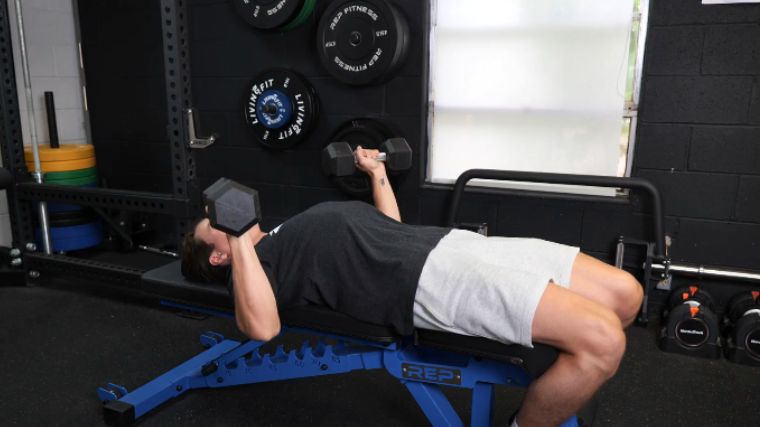One of the best attributes about the bench press is how versatile some of its variants can be and how you can increase pressing strength with multiple types of benching. In fact, you’d be hard pressed (pun intended) to now find a bench press variation that wouldn’t work for your training goals and needs.
When it comes to bench press variations, some lifters limit themselves to only thinking about incline, decline, flat, dumbbell, and so forth. However, within each of these variations come even more variations based on how each is performed. For example, simply shifting one’s grip from traditional to neutral is another way to create variation for the bench press.
What Is a Neutral Grip Bench Press?
No matter what implement you’re using, when performing a neutral grip press, the palms will be facing one another. Generally, neutral grip presses will be performed with dumbbells or a Swiss Bar (also referred to as a football bar).
In reality, any bench press variation (or exercise for that matter) that is performed with the palms facing one another is referred to as a neutral gripped exercise.
Why Use a Neutral Grip Bench Press?
Like with any movement variation, the intent in which it’s being performed is incredibly useful to understand. The use of movement variations should be individual per your needs, goals, and wants. So before randomly plugging in a neutral grip bench press into a program, it’s important to understand the “why” behind it.
1. Shoulder Discomfort Limitations
One of the biggest reasons lifters will employ neutral grip presses is due to shoulder discomfort from traditional benching. Shoulder discomfort can be caused by a number of factors, and these factors will be individual to what’s going on and causing any level of discomfort in the shoulders.
Generally speaking, if lifters are experiencing problems with benching at higher frequencies and want to keep working towards their upper body strength goals without taking time off from the specificity of the bench press’s movement patten, then a neutral grip variation is a great way to keep progressing. If the goal is strength, then opt for a Swiss bar, or heavy dumbbells.

[Read More: How to Bench Press With Dumbbells]
As a personal example, I have two ruptured AC joints and high bench press frequency aggravates my shoulders when in meet prep, so I’ll add a neutral grip variation one day out of the week to continue to strengthen my movement patterns and avoid aggravating my shoulders anymore than they need to be.
2. Context of Sport
This reason for use will be highly dependent on one’s sport and a coach’s methodology, but at times, a neutral grip press variation can be a great option for individuals who want to limit additional stress on their shoulders to avoid potential negative impacts on sport performance.
What does this mean exactly? Athletes such as baseball pitchers or any athlete that is already stressing their shoulder day-in and day-out with their sport might want to opt for a more joint-friendly option. This isn’t to say this population can’t traditionally bench press, but the context of the risk:reward ratio should be considered when selecting exercises for this type of athlete.
3. Triceps Focus
If we look at the neutral grip press mechanically, then it’s pretty easy to identify that the elbows track slightly tighter to the body when performing this variation. For this reason, the triceps will generally be used in a similar manner to what a close-grip bench press will facilitate.
Note, this will vary based on which grip you use on the Swiss Bar and how you track the dumbbells, but for the most part, the triceps will be active in a neutral grip press to a comparable level of what they are in a close-grip press.
[Read More: The Most Effective Workout Splits, Created by Our Experts]
Benefits of Using a Neutral Grip Bench Press
As with the reasons for why you would want to perform a neutral grip bench press, there are benefits that come along with this variation.
- Application to Sport: Outside of saving shoulder stress, this variation could have carryover to sports like football where one is actively grabbing and pushing opponents in a similar gripping fashion.
- Joint-Friendly for High-Volume: Performing hypertrophy sets with a neutral grip can be a useful tool for those who are usually limited when traditionally benching and trying to perform higher rep sets.
- Triceps and Chest Growth: Like mentioned before, the triceps can be targeted with this variation due to the extra elbow tuck required for success, but also, the chest can equally be targeted due to the stretch you can place on the pecs with a wider movement path.
- Mind Muscle Connection: This benefit will be variable based on your experience, but in my opinion, using a neutral grip dumbbell bench press is a fantastic way to focus on stretching the pec and really focusing on the mind muscle connection of this movement.
Author’s Note: This section is not intended to sway you from a traditional bench presses to neutral grip bench presses, but to simply highlight why it’s beneficial in certain contexts.
Wrapping Up
The neutral grip bench press, like every variation, has its time and place in workout programs. It’s a useful variation when working around shoulder issues and can be a fantastic variation for targeting the triceps and focusing on the mind muscle connection required to create a strong pec contraction.
Do you ever use neutral grip bench presses in your program? Drop a comment below!
Feature image from @heathrbarr Instagram page.